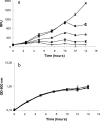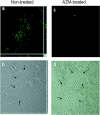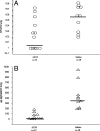Azithromycin blocks quorum sensing and alginate polymer formation and increases the sensitivity to serum and stationary-growth-phase killing of Pseudomonas aeruginosa and attenuates chronic P. aeruginosa lung infection in Cftr(-/-) mice
- PMID: 17620382
- PMCID: PMC2043275
- DOI: 10.1128/AAC.01011-06
Azithromycin blocks quorum sensing and alginate polymer formation and increases the sensitivity to serum and stationary-growth-phase killing of Pseudomonas aeruginosa and attenuates chronic P. aeruginosa lung infection in Cftr(-/-) mice
Abstract
The consequences of O-acetylated alginate-producing Pseudomonas aeruginosa biofilms in the lungs of chronically infected cystic fibrosis (CF) patients are tolerance to both antibiotic treatments and effects on the innate and the adaptive defense mechanisms. In clinical trials, azithromycin (AZM) has been shown to improve the lung function of CF patients. The present study was conducted in accordance with previous in vitro studies suggesting that the effect of AZM may be the inhibition of alginate production, blockage of quorum sensing (QS), and increased sensitivity to hydrogen peroxide and the complement system. Moreover, we show that AZM may affect the polymerization of P. aeruginosa alginate by the incomplete precipitation of polymerized alginate and high levels of readily dialyzable uronic acids. In addition, we find that mucoid bacteria in the stationary growth phase became sensitive to AZM, whereas cells in the exponential phase did not. Interestingly, AZM-treated P. aeruginosa lasI mutants appeared to be particularly resistant to serum, whereas bacteria with a functional QS system did not. We show in a CF mouse model of chronic P. aeruginosa lung infection that AZM treatment results in the suppression of QS-regulated virulence factors, significantly improves the clearance of P. aeruginosa alginate biofilms, and reduces the severity of the lung pathology compared to that in control mice. We conclude that AZM attenuates the virulence of P. aeruginosa, impairs its ability to form fully polymerized alginate biofilms, and increases its sensitivity to complement and stationary-phase killing, which may explain the clinical efficacy of AZM.
Figures







References
-
- Baldwin, D. R., R. Wise, J. M. Andrews, J. P. Ashby, and D. Honeybourne. 1990. Azithromycin concentrations at the sites of pulmonary infection. Eur. Respir. J. 3:886-890. - PubMed
-
- Baltimore, R. S., C. D. C. Christie, and G. J. W. Smith. 1989. Immunohistopathologic localization of Pseudomonas aeruginosa in lungs from patients with cystic fibrosis—implications for the pathogenesis of progressive lung deterioration. Am. Rev. Respir. Dis. 140:1650-1661. - PubMed
-
- Bjarnsholt, T., P. Ø. Jensen, M. Burmølle, M. Hentzer, J. A. J. Haagensen, H. P. Hougen, H. Calum, K. G. Madsen, C. Moser, S. Molin, N. Høiby, and M. Givskov. 2005. Pseudomonas aeruginosa tolerance to tobramycin, hydrogen peroxide and polymorphonuclear leukocytes is quorum-sensing dependent. Microbiology 151:373-383. - PubMed
Publication types
MeSH terms
Substances
LinkOut - more resources
Full Text Sources
Other Literature Sources
Medical

